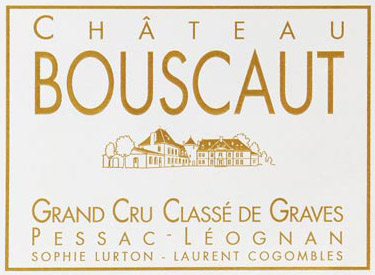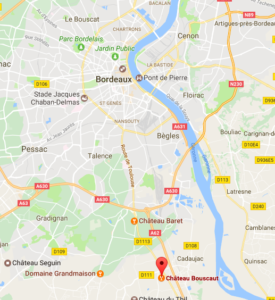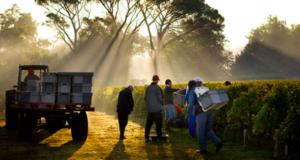
Overview

Château Bouscaut is one of the 6 Grands Crus Classés of Graves for both its white and red wines, in the Pessac-Léognan appellation. Sophie Lurton has been running Bouscaut, along with husband Laurent Cogombles for over 20 years.
Situated 34 m above sea level, Château Bouscaut’s vineyards spread out facing due south on the highest part of Cadaujac, a commune on the left bank of the Garonne River.
Château Bouscaut’s second-label wine is Les Chênes de Bouscaut. Château Lamothe-Bouscaut and Château Valoux are also part of the Bouscaut galaxy. They are all situated in the commune of Cadaujac.
History
Bouscaut’s vineyard has existed since the 17th century on the commune of Cadaujac, a Graves appellation at that time. Called Haut Truchon, it was renamed Château Bouscaut after the name on the land register in 1881 .
The various owners throughout the twentieth century were very dedicated to improving and transforming both the vineyard and the château. In the thirties, the domain was cited as being a model estate by the Chamber of Agriculture and a race horse called Château Bouscaut won first prize in the coveted Maisons Lafitte race. In the same period, a tower was added to the main residential building and cellars were erected next to it.
The winner of many medals, the wines of Château Bouscaut were widely recognized. Consecration came in 1953, when Bouscaut was awarded the envied status of Graves Cru Classé, for both its white and red wines.
In 1962, the château was completely destroyed by a fire while the cellars remained untouched. The owner, Victor Place, oversaw its reconstruction, to the exact original plans, before selling it to a group of investors from New York in 1968. The new owners brought in the directors of Haut-Brion to manage it.
 Bouscaut was then acquired in 1979 by Lucien Lurton, a well known Bordeaux winemaker who already owned at least ten other prestigious châteaux in appellations such as Margaux (Brane-Cantenac) or Barsac (Climens),…. This passionate viticulturist recognized the potential and exceptional terroir of Château Bouscaut.
Bouscaut was then acquired in 1979 by Lucien Lurton, a well known Bordeaux winemaker who already owned at least ten other prestigious châteaux in appellations such as Margaux (Brane-Cantenac) or Barsac (Climens),…. This passionate viticulturist recognized the potential and exceptional terroir of Château Bouscaut.
Sophie Lurton, Lucien’s daughter has been looking after Bouscaut since 1992. Laurent Cogombles, her husband, an agronomist, has also been very involved since 1997. Laurent is also the current President of the Appellation Pessac-Léognan.
Today, Château Bouscaut continues its journey, led with enthusiasm and innovation by its owners and team.
Château Bouscaut has recently joined a program of environmentally friendly practices.
Wine tourism is permanently evolving with various workshops available to do and the house at Château Valoux has been available for rental since 2011.
The Vines
The majority of the vines are red, covering 47 hectares, consisting of 55% Merlot, 40% Cabernet Sauvignon, and 5% Malbec. The remaining 7 hectares are divided equally between Semillon and Sauvignon Blanc. Overall, there is a vine density of 7,200 vines/ha. The average age of the vines is 40 years -although there are some that are over a hundred years old.
Vinification
The harvest is manually picked and put into small baskets, followed by temperature controlled fermentation (24-28ºC) in stainless steel and cement vats for the reds, and a cooler ferment (18-22ºC) in oak barrels (50% new) for the whites. The reds will see up to 18 months in oak, the whites up to a year with regular bâtonnage.

Château Bouscaut Pessac-Léognan
Appellation: Pessac-Léognan
Owners: Sophie Lurton & Laurent Cogombles
Average Age of the Vines: 35 years old
Soil: Clayey-calcareous and gravel
Grape Varieties: Merlot 48%; Cabernet Sauvignon 42%; Malbec 10%
Average Production: 40 hl/ha
Alcohol Content: 14.5%
Vinification: Fermented in stainless steel and concrete tanks, aged in oak barrels (45% new oak)
Food Pairings: Enjoyable with game birds, various meats, and soft cheese such as a good Camembert.

Les Chênes de Bouscaut Rouge
Appellation: Pessac-Léognan-Grand vin de Graves (Bordeaux)
Town: Cadaujac
Owners: Sophie Lurton & Laurent Cogombles
Soil: Clay on limestone bedrock
Average Age of Vines: 35 years
Average Production: 40 hl /ha
Grape Varieties: 72% Merlot; 28% Cabernet Sauvignon
Vinification: Stainless steel tanks and concrete with temperature control by water circulation
Food Pairings: Seafood such as sole, bar, saint-pierre, cabillaud, salmon, trout, etc. White meat such as poultry, veal, sweetbreads. Roasted or braised red meat. Cheeses with character, refined with strong aromas. Hard cheeses like cantal, tomme, and comté.


